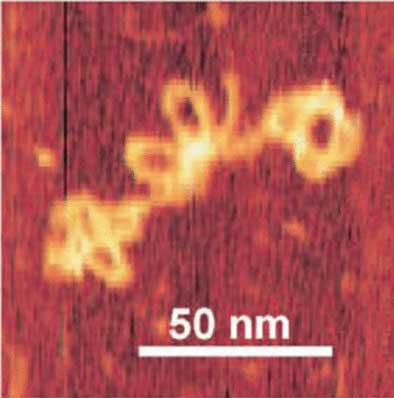| Posted: Mar 31, 2016 |
Nanostructures made from DNA: Daisy chain rotaxanes as molecular bearings
(Nanowerk News) In order for a machine to perform work, it needs parts that move relative to each other. This also holds true for nanoscale machines. German scientists have now used DNA molecules to make a nanoscale component that makes it possible for two individual parts to move relative to each other. As reported in the journal Angewandte Chemie ("Daisy Chain Rotaxanes Made from Interlocked DNA Nanostructures"), this component could be used as a molecular guide bearing and may form the basis for more complex systems.
|
 |
| Nanostructures made from DNA - Daisy chain rotaxanes as molecular bearings. (© Wiley-VCH)
|
|
DNA is an excellent material for the nanoscale: It forms a very stable framework and additional components can be attached at any desired location by the removal of one strand for use as an attachment site. Addition of functional groups is also no problem. It is thus possible to build complex systems from DNA molecules.
|
|
The team headed by Michael Famulok at the University of Bonn has chosen to build their moveable components as rotaxanes. These are a class of molecule in which one or more molecular rings are “threaded” onto an axis. They can move freely along and around the axis and are prevented from slipping off by “stoppers”. If the DNA rings themselves are bound to the end of an axle, the rings can be threaded onto a second axle and vice versa. In this case, the stoppers consist of two mutually entwined DNA rings with a spherical shape. After attaching stoppers to the free ends of the axles, the researchers obtained two interwoven, dumbbell-shaped structures that can move freely along the axles. This allows the two dumbbells to be pushed toward each other linearly along the axles. Daisy chains are formed in a similar way, so these special rotaxanes are also known as daisy chain rotaxanes.
|
|
How do the researchers thread the two DNA molecules together? To achieve this, Famulok and his co-workers turned to specific base pairing. Both in the middle of the axles and at one location on the edge of the ring, they left a “gap” of single-stranded DNA. The sequences of these single strands are complementary to each other. When the single-stranded regions of the ring and axle come into contact with each other, they bind to each other, “gluing” the rings and axles of two molecules together. If short, single strands of DNA complementary to these regions are then added, this “sticking point” between the axle and ring is released, allowing the ring to slide along the axle.
|
|
This results in a moving structure that can act as a molecular slide bearing or transmission for nanomachines. More nanoscopic machine components should follow. The researchers can imagine a whole series of novel components based on mechanically bound double-stranded DNA.
|

